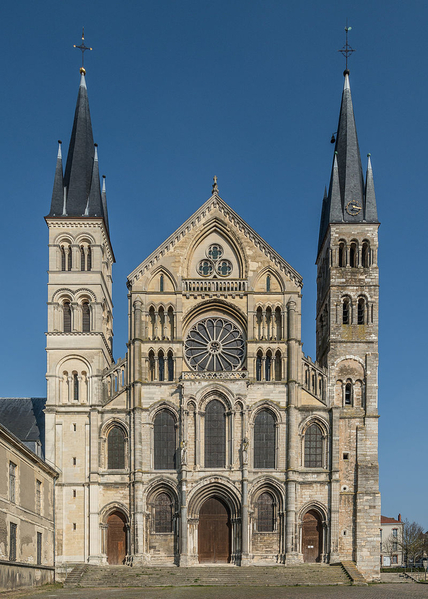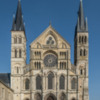Where Gumbo Was #465
Reims, the unofficial capital of France's Champagne region, doesn't lack for important churches. Not only does it have one of the best-known of France's cathedrals, where all but a few of France's kings were crowned, it has a 'spare,' which is itself the largest Romanesque church in northern France.
 Wikimedia/Daniel Vorndran
Wikimedia/Daniel Vorndran
Over the centuries, the church, and especially the exterior, garnered enough Gothic additions that its Romanesque origins are not always readily clear.
When I wandered off from Paris on a day-trip last fall, I only had in mind the grand cathedral, and the small museum marking the spot where World War II in Europe came to its formal end. It was only when I stopped at the visitor info at the station to pick up a map that my attention was drawn to another grand church, and to the small visitor bus that loops past both churches and a clutch of Champagne bottlers.
The Basilica of Saint-Remi doesn't get nearly the attention the cathedral does, though it is as old, nearly as large and has quite a history of its own. When the present church was built in the 11th century, it was important enough that Pope Leo IX traveled north to consecrate it in 1049.
Perhaps that was because of the significance of the man for whom it was named in the history of Christian France. Saint Remigius, or Remi, was the bishop who, in 496 AD, converted Clovis, King of the Franks and baptized him in a chapel on the site of the present Basilica. Oddly, the stone (above) that marks the spot of the baptism has been removed to the Cathedral.
Remigius was an important and influential theologian, but perhaps more importantly he was the recipient from Clovis of vast tracts of land, which produced serious income for the Church. Remigius used it, and the King's support, to build churches and create new dioceses all over the area, helping to guarantee that the conversion would outlive the king.
When Remigius died in 533, at age 96, he was buried in the chapel of St. Christophe, where he had baptized Clovis. A new church was built in the 9th century, but because it became a popular pilgrimage site, a bigger church was soon called for.
The stacked galleries emphasize the great height of the church
The present Basilica, served both to honor the saint and to serve as centerpiece of a Benedictine abbey which was created there. Bits of the older churches are under and part of the new.
Over the years, Saint-Remi grew additions and embellishments, even while the nearby cathedral became the center of religious life in the city. The interiors are some of the most impressive I've seen anywhere.
When the French Revolution put an end to the monastic community of the abbey in 1792, the church suffered relatively little damage, although the tomb of Saint Remigius was destroyed. In 1841, during the reign of France's last Bourbon king, it was designated as a historical monument. A number of sculptures from razed churches arrived at Saint-Remi, including this 1531 rendering of the burial of Jesus.
During World War I, Reims changed hands several times and was shelled by both sides; Saint-Remi and the Cathedral both suffered heavy damage, and both were painstakingly restored. The same architect, Henri Deneux, was in charge of both projects. The Cathedral was finished in 1938; the work at Saint-Remi wasn't finished until after World War II.
The impressive tomb of Saint-Remi, above, is, of course, not the original. In fact, the Saint traveled quite a bit after his death. His relics spent a few centuries at the Cathedral, and even spent some years in Epernay, where they were moved during Viking invasions of France. The present tomb was built in 1847 to replace the 16th-century version that was destroyed in 1792.
Other tombs are in the building, though unmarked. They include several Frankish kings, including Carloman, brother of Charlemagne.
Near the church, the remaining building of the old abbey is now an art and archaeology museum; I would have added it to my agenda, but sadly it was closed the day I was in Reims.
Congratulations to ProfessorAbe, GeorgeG and PortMoresby, who all recognized the Basilica in this week's Where in the World is TravelGumbo!


Comments (1)